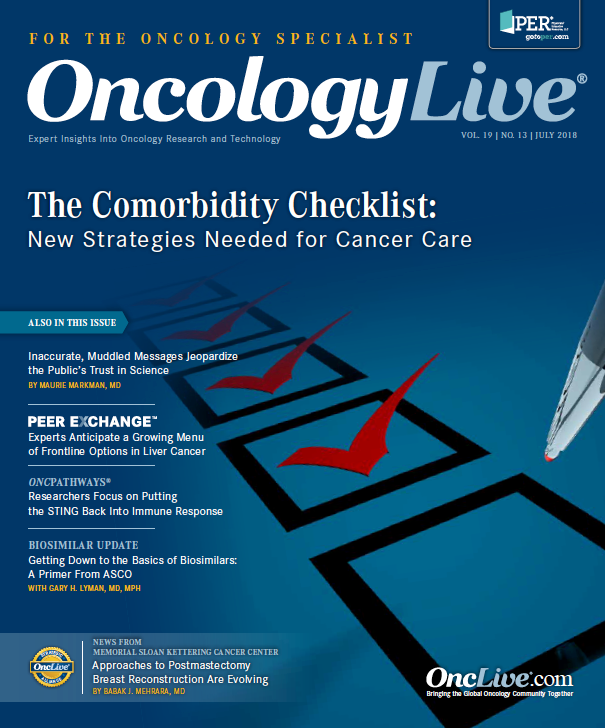Approaches to Postmastectomy Breast Reconstruction Are Evolving
Emerging evidence shows that immediate autologous breast reconstruction can tolerate radiotherapy better than previously thought in select cases.
Babak J. Mehrara, MD

Babak J. Mehrara, MD
Chier, Plastic and Reconstructive
Surgical Service
Peter G. Cordeiro Endowed Chair in Plastic and Reconstructive Surgery
Memorial Sloan Kettering Cancer Center
Radiation can have major deleterious effects on the cosmetic outcomes of reconstructive procedures.1 As a result, the timing of reconstruction in women who may require postmastectomy radiotherapy (PMRT) is a heavily debated topic. Now, emerging evidence shows that immediate autologous breast reconstruction can tolerate radiotherapy better than previously thought in select cases.
Some surgeons consider PMRT to be a relative contraindication to immediate reconstruction and advise women to undergo mastectomy, PMRT, and then reconstruction 6 to 12 months later. Increasingly, however, other surgeons take into consideration the psychological and technical benefits of immediate reconstruction and recommend it, recognizing that outcomes in these women may be suboptimal although still equivalent or superior to delayed reconstruction.
In a recent paper published in the Lancet Oncology in December 2017,1 colleagues from Memorial Sloan Kettering Cancer Center (MSK) and 3 other academic cancer centers collaborated to summarize the challenges, controversies, and latest evidence on the optimal approaches for integrating postmastectomy radiotherapy with breast reconstruction.
The rates of immediate reconstruction have steadily increased over the period from 2001, with bigger jumps in the past 5 years. Whereas only 15% of women who underwent mastectomy had immediate reconstruction in 2011, this number has increased to about 40% in 2018.2-4 This is important because immediate reconstruction can offset the psychosocial and physical consequences of mastectomy. In addition, immediate reconstruction is technically easier to perform than delayed reconstruction due to decreased scarring and preservation of the breast contours.
These reconstructive trends have coincided with the increasing use of postmastectomy radiotherapy in women with locally advanced breast cancer.4
Temporary Implants in Women Who May Need Radiation
Autologous Reconstruction and PMRT Timing
In our study, we found a wide spectrum of choices for the type of reconstruction and timing of procedures. One of the most significant insights was the emerging evidence that in select cases, immediate autologous reconstruction can tolerate radiotherapy better than previously thought. We also found that the timing of radiation treatment for patients who have implant reconstruction does not significantly affect the final outcome and should be individualized depending on clinical and other factors.1In some women, it is unclear whether they will require PMRT until their mastectomy and lymph node sampling are performed. This is a reconstructive dilemma, because it is difficult to provide adequate counseling regarding the potential effects of PMRT on cosmetic outcomes. In some cases, using temporary implants (tissue expanders) is helpful because it enables the plastic surgeon to preserve the breast skin and contours after mastectomy while awaiting the decision for PMRT following review of the pathology results. This approach preserves the woman’s choice to undergo implant or autologous reconstruction and facilitates delivery of PMRT.Historically, most surgeons have not recommended autologous tissue reconstruction in patients who will require PMRT. This position stems from a 2001 study that found higher rates of fat necrosis and volume in women who underwent immediate reconstruction with autologous tissues followed by subsequent treatment with PMRT.5
However, later evidence in a 2014 systematic review found that autologous reconstruction results in acceptable outcomes in select patients who undergo PMRT following reconstruction.6 These authors suggested that immediate reconstruction with autologous tissue is a viable approach in women who have adequate tissue to compensate for the shrinkage that may occur following PMRT.
Implant Reconstruction and PMRT Timing
Another study by the Mastectomy Reconstruction Outcomes Consortium (MROC)—the most compelling prospective evidence to date—analyzed results for 175 women who received either immediate or delayed autologous reconstruction with PMRT at 11 North American centers. There was no significant difference in postoperative complications between the groups after 1 year (25.9% and 26.9%, respectively; P = .54).7 More important, women who had immediate reconstruction had improved patient-reported outcomes and satisfaction with their reconstruction.Implants also are a viable option for some women who require PMRT. In most cases, these procedures are performed as a 2-stage process in which a temporary implant (a tissue expander) is placed after the mastectomy, inflated over time with saline in follow-up visits, and switched to a permanent implant after chemotherapy ends.
Advancing the Integration of PMRT and Breast Reconstruction
For women who require PMRT, there has been much debate regarding optimal timing for the expander-implant exchange relative to PMRT. Work published by my colleagues at MSK has suggested that the exchange of the expander to the final implant prior to PMRT results in improved outcomes. However, prospective data from a 2016 MROC study showed no difference in outcomes between those who received radiotherapy delivered to a tissue expander compared with those with a permanent implant.8 Clearly, this topic requires additional study.New surgical and radiotherapy techniques have significant potential to improve patient outcomes in the future. Advances in radiotherapy techniques— including intensity-modulated radiation therapy, volumetric-modulated arc therapy, and proton therapy—are exciting options that require further study.
Choosing the optimal treatment plan requires multidisciplinary coordination between the patient, breast surgeon, plastic surgeon, medical oncologist, and radiation oncologist. At MSK, the highest-volume breast cancer referral center in the United States, doctors perform more than 400 autologous breast reconstructions and nearly 1000 implant-based reconstructions annually. MSK is committed to helping women with breast cancer achieve the best possible outcomes.
References
- Ho AY, Hu ZI, Mehrara BJ, Wilkins EG. Radiotherapy in the setting of breast reconstruction: types, techniques, and timing. Lancet Oncol. 2017;18(12):e742-e753. doi: 10.1016/S1470-2045(17)30617-4.
- Agarwal S, Kidwell KM, Farberg A, Kozlow JH, Chung KC, Momoh AO. Immediate reconstruction of the radiated breast: recent trends contrary to traditional standards. Ann Surg Oncol. 2015;22(8):2551—2559. doi: 10.1245/s10434-014-4326-x.
- Frasier LL, Holden S, Holden T, et al. Temporal trends in postmastectomy radiation therapy and breast reconstruction associated with changes in National Comprehensive Cancer Network guidelines. JAMA Oncol. 2016;2(1):95—101. doi: 10.1001/jamaoncol.2015.3717.
- Razdan SN, Cordeiro PG, Albornoz CR, et al. National breast reconstruction utilization in the setting of postmastectomy radiotherapy. J Reconstr Microsurg. 2017;33(5):312—317. doi: 10.1055/s-0037-1598201.
- Tran NV, Chang DW, Gupta A, Kroll SS, Robb GL. Comparison of immediate and delayed free TRAM flap breast reconstruction in patients receiving postmastectomy radiation therapy. Plastic Reconstr Surg. 2001;108(1):78-82.
- Kelley BP, Ahmed R, Kidwell KM, Kozlow JH, Chung KC, Momoh AO. A systematic review of morbidity associated with autologous breast reconstruction before and after exposure to radiotherapy: are current practices ideal? Ann Surg Oncol. 2014;21(5):1732—1738. doi: 10.1245/s10434-014-3494-z.
- Billig J, Jagsi R, Qi J, et al. Should immediate autologous breast reconstruction be considered in women who require postmastectomy radiation therapy? a prospective analysis of outcomes. Plast Reconstr Surg. 2017;139(6):1279—1288. doi: 10.1097/PRS.0000000000003331.
- Santosa KB, Chen X, Qi J, et al. Postmastectomy radiation therapy and two-stage implant-based breast reconstruction: is there a better time to irradiate? Plast Reconstr Surg. 2016;138(4):761—769. doi: 10.1097/PRS.0000000000002534.




